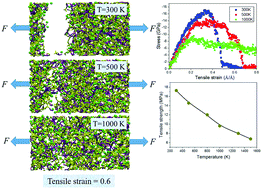Molecular structure, dynamics, and mechanical behavior of sodium aluminosilicate hydrate (NASH) gel at elevated temperature: a molecular dynamics study
Abstract
Sodium aluminosilicate hydrate (NASH) gel is the primary adhesive constituent in environmentally friendly geopolymer. In this study, to understand the thermal behavior of the material, molecular dynamics was utilized to investigate the molecular structure, dynamic property, and mechanical behavior of NASH gel subjected to temperature elevation from 300 K to 1500 K. The aluminosilicate skeleton in NASH gel provides plenty of oxygen sites to accept H-bond from the invading water molecules. Upon heating, around 18.2% of water molecules are decomposed and produce silicate and aluminate hydroxyls. About 87% of hydroxyls are associated with the aluminate skeleton, which weakens the Al–O bonds and disturbs the O–Al–O angle and the local structure, transforming it from an aluminate tetrahedron to a pentahedron and octahedron. With increasing temperature, both Al–O–Si and Si–O–Si bonds are stretched to be broken and the network structure of the NASH gel is gradually transformed into a branch and chain structure. Furthermore, the self-diffusivity of water molecules and sodium dramatically increases with the elevation of temperature, because the decrease in connectivity of the aluminosilicate network reduces the chemical and geometric restriction on the water and ions in NASH gel under higher temperatures. The high temperature also contributes to around 63% of the water molecules further dissociating and hydroxyl groups forming; meanwhile proton exchange between the water molecules and aluminosilicate network frequently takes place. In addition, a uniaxial tensile test was utilized to study the mechanical behavior of the NASH gel at different temperatures. During the tensile test, the aluminosilicate network was found to depolymerize into a branch or chain structure which plays a critical role in resisting the tensile loading. In this process, the breakage of the aluminosilicate skeleton is accompanied with hydrolytic reactions that further deteriorate the structure. Due to the reduction of the chemical bond stability at elevated temperature, both the tensile strength and stiffness of the NASH gel are weakened significantly. However, the ductility of the NASH gel is improved because of the higher extent of structural arrangement at the yield stage and partly due to the lower water attack. Hopefully, the present study can provide valuable molecular insights on the design of alkali-activated materials with high sustainability and durability.



 Please wait while we load your content...
Please wait while we load your content...